{Click on an image to enlarge, then use the back button to return to this page}
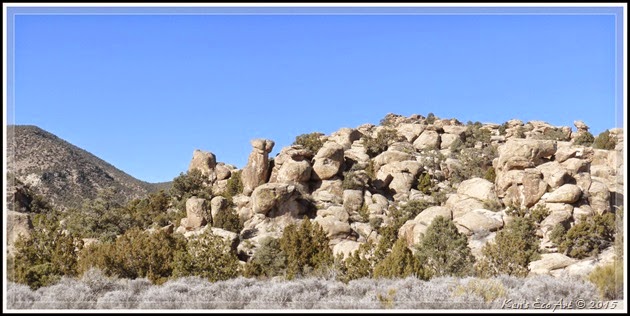 |
| (Fig. 01) |
|
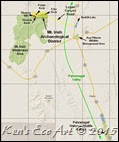 |
| (Fig. 02) |
Directions: Mt. Irish Rock Art and Archaeological District is located in the Pahranagat Valley (Fig. 02), about 110 miles north of Las Vegas. From Las Vegas, drive north on I-15 to US Highway 93. Turn left onto US Highway 93 and drive north past the towns of Alamo and Ash Springs to the intersection of Highways 93 and 318. The entrance and gate to Mount Irish Rock Art Site is 3.9 miles from the intersection of State Route 375, State Route 318 and U.S. Route 93 (the “Y”). Traveling north on State Route 318, towards Ely, it is on the left (west) side of the road just past Key Pittman Management Area. A yellow BLM marker is just to the left of the gate. Go through the gate, and continue approximately 12.0 miles, about a quarter mile past Paiute Rock, to Shaman Hill & Shaman Knob, the final petroglyph area in the District (Fig. 03).
|
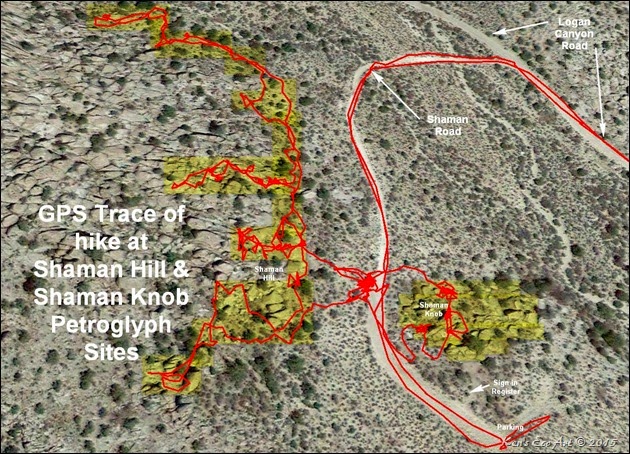 |
| (Fig. 03) |
|
01/21/2015 Trip Notes: Shaman Hill is one of the major public petroglyph sites in the district and consists dozens of panels on a large hill that is covered with hundreds of boulders and outcrops (Fig. 01). The BLM has placed eight numbered markers around this site, and produced a brochure [Mt. Irish Trail Guide.pdf] that provides information on the trail and each of the panels found here. If you’re lucky, you might fine one in the metal sign-in kiosk near the front of the site. As is true at most petroglyphs sites, the designs vary greatly — some are complicated and hard to distinguish, while others seem to be obvious depictions of people or animals. Based on examples of rock art from other indigenous people, one can pose some possible explanations, though, because no one has lived at these sites for hundreds of years, it is likely that definite conclusions will never be achieved.
|
At the first marker behind the sign-in kiosk, there is a grouping of boulders (Fig. 04), one of them containing a large Pahranagat anthropomorph (Fig. 05). Unfortunately, this “bird like” figure’s head and left arm are partially covered by lichen. Again, it is sad to see how much of the surface faces on these boulders have deteriorated over time due to weather and the natural ageing process. Moving to the right, behind this panel is another large panel containing what has been described as a “bee hive” cluster and several bighorn sheep (Fig. 06). The combination of the light and dark pecking's of the sheep at the bottom of the panel (Fig. 07) many be an indication, that over time, this panel was worked on by two different cultures or tribes. At marker #2, as you continue to your right, you will see a large fractured boulder with numerous elements and motifs.The circled crosses found in the upper right corner (Fig. 08) occur in rock art throughout many regions in North America, and therefore are not unique to the Mt. Irish site. It is not easy to attribute a specific function or meaning to these pecked cross-circle motifs, and even though many have offered possible explanations ranging from solar symbols and stars, to the sun, these, and similar motifs continue to fuel additional speculation about their meaning and why the Native Americans carved them into rocks. The next panel, (Fig. 09), has what appears to be a horned figure resembling the body of a Pahranagat Man. There is possibly an atlatl being held by the figure. At the next panel (Fig. 10), it has been suggested that the element may be representative of a “blanket”. The last panel in the first grouping is a large, well preserved, solid body Pahranagat anthropomorph (Fig. 11). I don’t understand why the brochure notes that this figure may be a female. I see nothing that might suggest that.
If you view the first five panels in order, you have to backtrack to locate the last three identified panels. The brochure describes the very large panel behind marker #6 as the “lizard panel” (Fig. 12). In addition to what appear to be a couple of lizards, this very busy panel appears to have several sheep, what may be a fence, a circle, and a zoomorph with a slim body and short legs that might be either a fox or a coyote, top of (Fig. 13). At marker #7 you will look down on a large boulder that has a patterned body anthropomorph (Fig. 14). In front of marker #8, the last panel in the brochure, described as the “many sheep” panel, there are some eight or nine well defined bighorn sheep (Fig. 15). One interesting feature here is the direction of the horns on the third sheep from the left in the top row, leading one to wonder if their is some special significance as to why they are pointing forward. |
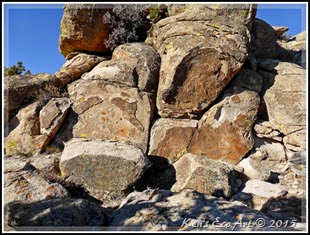 |
| (Fig. 04) |
|
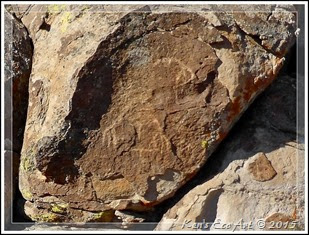 |
| (Fig. 05) |
|
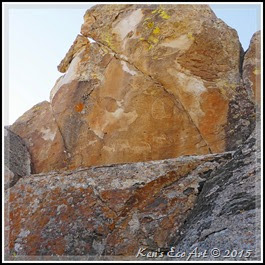 |
| (Fig. 06) |
|
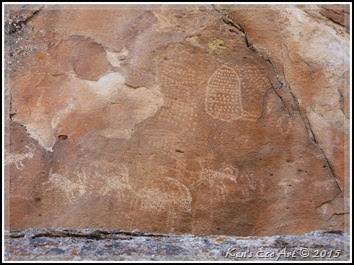 |
| (Fig. 07) |
|
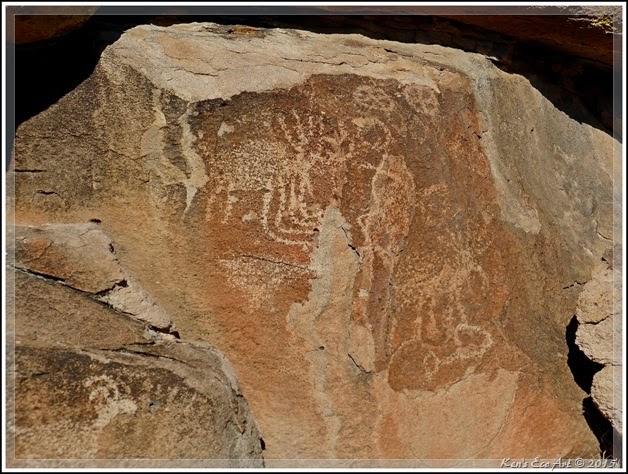 |
| (Fig. 08) |
|
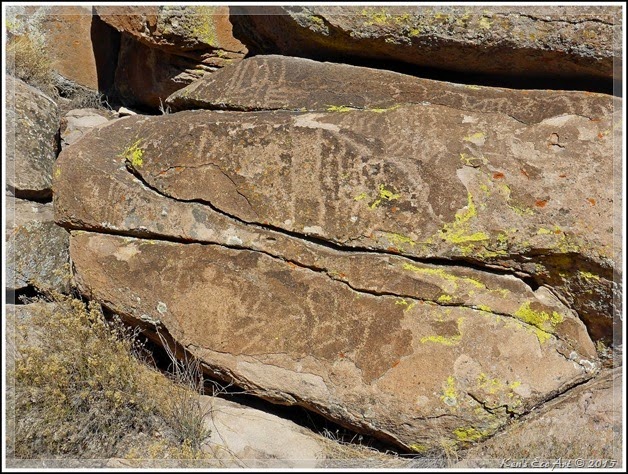 |
| (Fig. 09) |
|
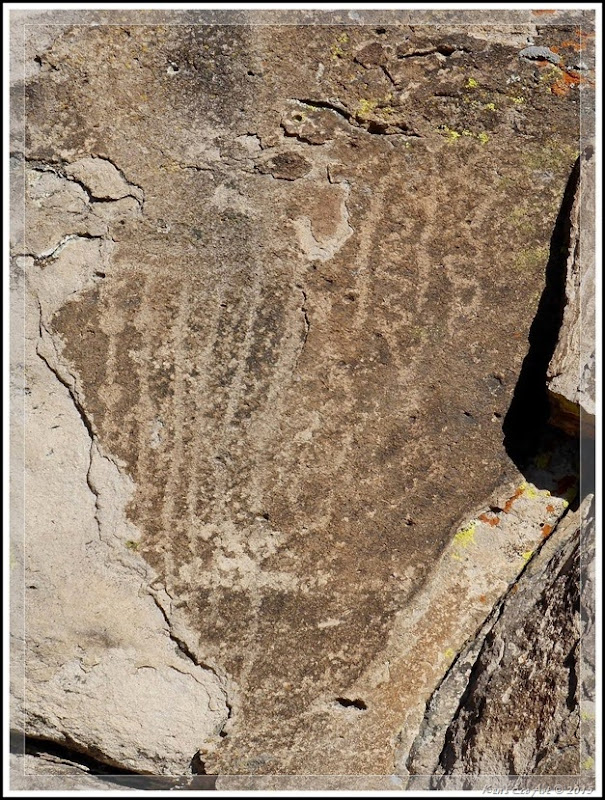 |
| (Fig. 10) |
|
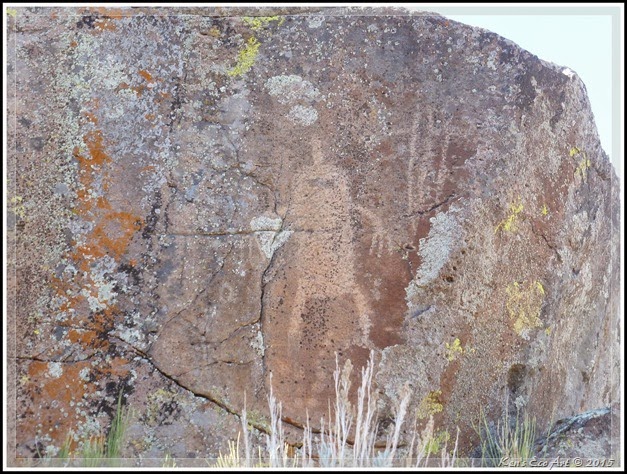 |
| (Fig. 11) |
|
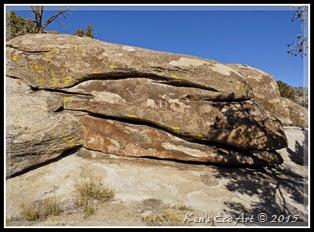 |
| (Fig. 12) |
|
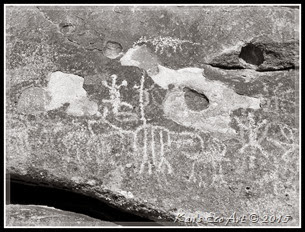 |
| (Fig. 13) |
|
|
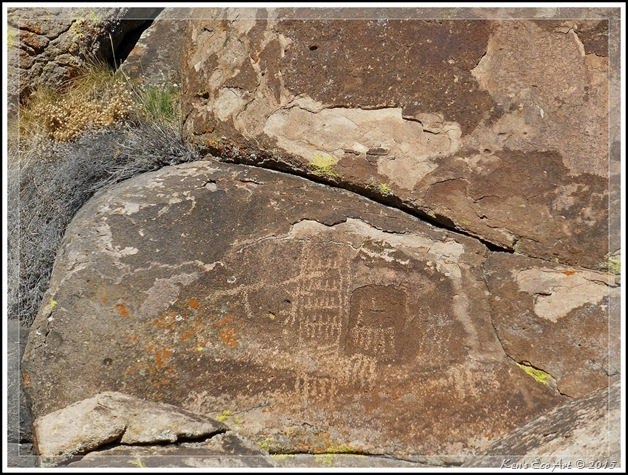 |
| (Fig. 14) |
|
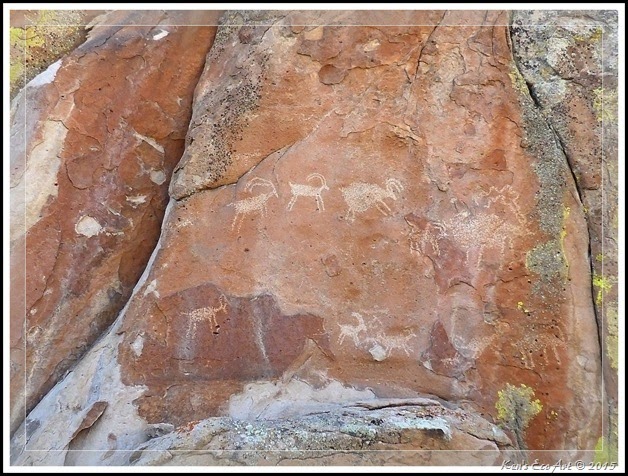 |
| (Fig. 15) |
|
Whenever I go hiking I am always looking for rock shapes that I feel represent a recognizable familiar image. As we rounded a bolder area at Shaman Hill, we all agreed that the picture shown in (Fig. 16) looked like a humongous desert tortoise. The collage in (Fig. 17) is a compilation of various glyphs found at this site.
|
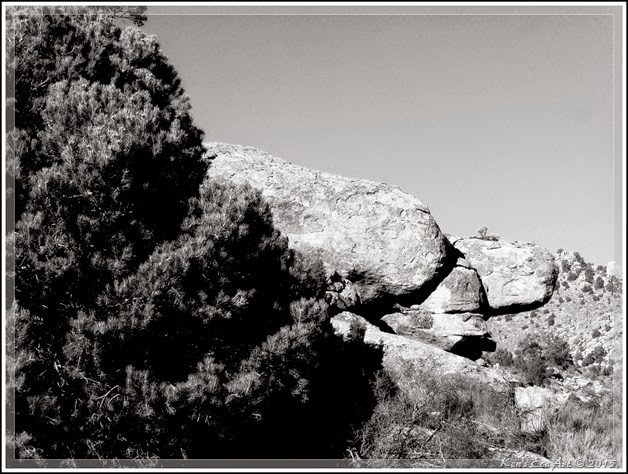 |
| (Fig. 16) |
|
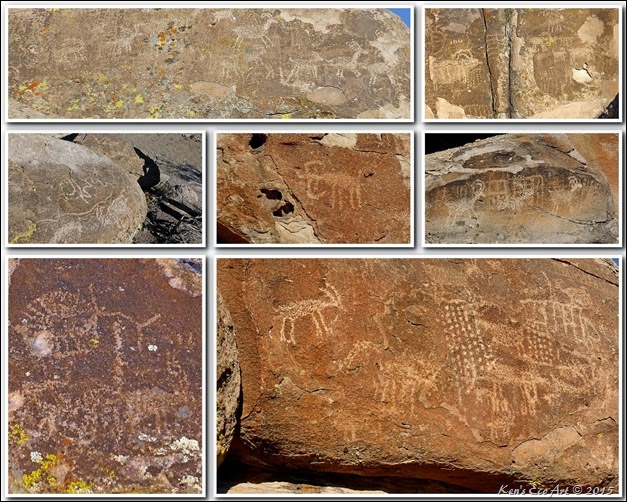 |
| (Fig. 17) |
|
|
Site History: It is believed that today's Paiutes and Shoshones are direct descendants of the last hunter-gathers in southern Nevada. Peoples who, during the past several thousand years, were experts in living in an arid environment. Roaming on a seasonal basis in search of natural resources (water, plants and seeds) and game (bighorn sheep and deer), they lived in caves and brush structures in small open camps. Petroglyphs, as well as other archaeological finds, suggest that these sites were occupied from around 1000 B.C. to the 1860's.
The rock art found in the hills surrounding the Pahranagat Valley are representative of the three different cultures and have been classified with three distinct styles: The Great Basin Abstract Style, that is predominately abstract symbols (circles, grids, etc,); the Pahranagat Representational Style (bighorn sheep, deer and anthromorphs – human-like characters with rectangular bodies and solidly pecked out bodies and heads); and the Fremont Representational Style, that resembles the classic trapezoidal bodied Anthromorphs and Quadrapeds.
It is believed that various distinctive cultures, known today as the Desert Archaic, Fremont, and Southern Paiute, visited these areas. By AD 1300, the Fremont had disappeared from the archaeological record of Southern Nevada, perhaps as a result of long-term droughts or other, as yet, unknown factors. Most of the petroglyphs have been classified as the "Great Basin Representational" style (A.D. 1-1500). In general, the Pahranagat Valley was a winter site for a group of peoples known as the "Pahranagats", one of several Southern Paiute groups. In recent years, archaeological evidence indicates that some Southwestern groups co-existed in this area along with the Pahranagats c. AD 500-1250. Evidence of the Pahranagats and their way of life can be found throughout Lincoln County's network of interrelated rock art sites including: Ash Springs, Crystal Wash, Mount Irish, Rainbow Canyon, Shooting Gallery and White River Narrows. Click the following link to learn more about Nevada Rock Art ...
Understanding Nevada Rock Art.

















